
|
if your browser doesn't support the menu, please use the links at the
bottom of the pages
|
||

| The majority of the population is concentrated in the south-west corner of the country where the main crops are grown: Millet, sorghum, maize, tomatoes, onions, potatoes and rice, and cattle and sheep are reared. In fact, Niger is quite sparsely populated, the total population being around 8 million, and is made up mainly of nomadic Tuareg and Peulh (Woodabe) as well as the more settled Hausa, Zarma and Kanuri peoples. The official language is French and the commonly spoken languages are Hausa, Djerma and Tamasheq (Tuareg). | ||
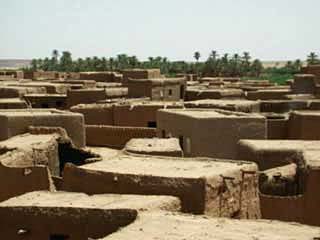 |
||
Ingal rooftops; photo:web |
||
| Half-naked kids played soccer amid great laughter and shouting with a ball made up of old cotton scraps. Young women in colorful attire busily went their way, many carrying a tiny baby tied to their backs and one or two toddlers in trail, while carefully balancing water jugs for their family's needs on their heads. A group of turbaned and veiled Tuareg braves, swords in red leather scabbards dangling at their sides, walked by at a leisurely pace. Right in the middle of the road, oblivious of all that went on around him, a middle-aged fellow stood in deep concentration, hunting for lice in the waistband of his cotton trousers. | ||
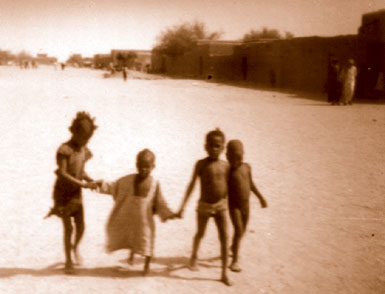 |
||
kids on Ingal's main street |
||
 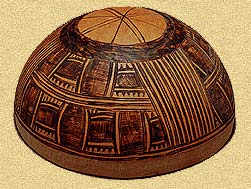 |
||
upturned calabash bowl and ladle, photo:web |
||
| Next we had to buy the necessary minimum of household utensils, mainly two cooking pots, some spoons and bowls made of calabash gourds, a knife, a few enameled Chinese tin plates with their typical colorful flower designs, a water jug and a broom. To be able to cook our meals we also needed a basic stock of provisions, consisting mainly of rice, couscous, pasta, dried tomatoes and dates, sold out of big sacks at the tiny grocery shop on Ingal's main road. | ||
 |
||
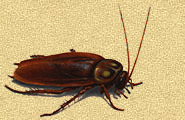 |
||
| Now as long as the roaches were up on the walls, no problem. What made us feel uneasy though was the possibility of squatting right over the hole the moment the critters chose to start their daily ascent. Imagine them crawling all over your feet and maybe even starting to climb your legs. Eeechhh! | ||
| I've had to share my rooms with cockroaches (and worse) often on my travels, but never have I seen those insects behave in such a weird way. Usually they just scurry about everywhere at night, each on its own, and at a good speed. Nowhere else did I see this strange spectacle of those roaches' slow nightly ascent and subsequent descent. As to the purpose of that ritual, I have no clue. It wasn't about food, that much is for sure. There was more than enough of that inside the toilet cavity, while the plain walls were bare of anything edible. I had to file this away as yet another one of life's unsolvable mysteries. | ||
| For a shower, there was a walled cubicle where water could be splashed over the body by means of a small jug, a technique common to Asia, Africa and South America, and probably to a lot more places where tap water isn't prevalent. The used water ran out into the street through a small hole in the wall at floor level. | ||
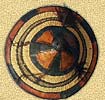 |
||
| Far more fascinating were the rather bizarre looking folks squatting in groups on the market square. Some of the men wore animal skins tied around their middle and coned hats fashioned of leather and straw, while the women had their ears adorned with dozens of huge metal rings and wore their hair in a rather elaborate style. Those gentle nomadic herders of the Fulani ethnic group are called Bororo or Peulh; alternately they are known as Woodabe. They make up only about 2% of Niger's population. | ||
 |
||
group of Peulh nomads |
||
Proud, aloof Tuareg men, their heads and faces up
to the eyes hidden by turban cloth, looked very mysterious if not outright
romantic. Same as the Peulh, the Tuareg came into town, if a village
consisting of mud houses can be called as a such, for shopping or business,
but lived in their tents out in the desert. |
||
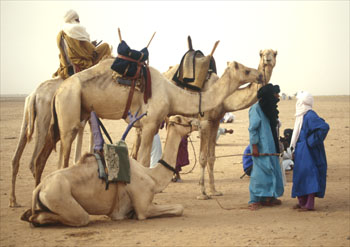 |
||
Tuareg men with their camels at
Ingal, photo: web |
||
|
||
| The only exception were the Peulh or Fulani, those never bothered us with the inevitable "Ou est mon cadeau?" (where is my present?), they always were relaxed and in a bantering mood, and much less concerned with material matters than their compatriots. Unfortunately, we didn't have the chance to really get acquainted with any of the Peulh. They seemingly only spoke their own language, so any attempt at communication was reduced to a few gestures and smiles. What I remember most vivid though was the visibly pleasant disposition and the lighthearted laughter of those truly unspoiled children of the Sahel. | ||
| With the Tuareg we could communicate at least on a very basic level, using a few French words and some scraps of Arabic, the latter being often understood by elders versed in reading the Quran. | ||
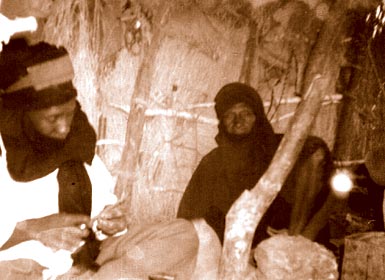 |
||
Moussa Mohamed, the black Tuareg silversmith,
and his father |
||
 |
||
Tuareg earrings in original "little girl"
size |
||
| The following year I brought the earrings to a Cairo silver smith who made me an exact copy of better quality silver; those I was to wear day and night for many years to come; those are still in my possession. Later, when my baby daughter was sitting in my lap trying to stand up, she'd use them as handholds to pull herself up with. Sounds bad, but actually, due to earrings thickness it didn't hurt at all. | ||
| Other pieces of Tuareg jewelry encountered in Niger are the various "crosses". Those are amulets worn around the neck, and each place has its unique shape and design. | ||
 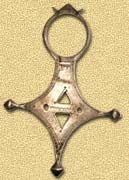  |
||
crosses of Zinder, Tahoua and Ingal |
||
| I have lost my Ingal cross many years ago, but still have the Zinder one. | ||
| Founded by the 11th century, Agadez developed because of its location on trans-Saharan caravan routes linking Egypt and Libya with the Lake Chad area. Agadez remained a trade center until the late 19th century. During much of this time it was a center of Islamic learning as well. The French occupied the town in the early 20th century. Mines of tin, tungsten, uranium and salt are found nearby. | ||

|
||
Agadez with its 16th-century mosque; photo:
web |
||
| At Agadez evidently a few more foreigners had passed through than at Ingal. One, a Swiss explorer, writer and photographer by the name of René Gardi (1909 - 2000), well known to me from the radio of my childhood days, definitely had left his mark: Grinning street urchins astonished us with expressions like "René Gardi isch guet" and "Chuchichäschtli". The later means "kitchen cupboard"; a word near to impossible for non-Swiss to pronounce. Swiss travelers generally consider it great fun to teach it to the locals wherever they go. | ||
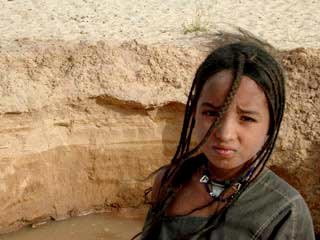 |
||
young Tuareg girl of Agadez; photo: web |
||
| There never was an agreement about us feeding the boy, he came of his own will to share our meals. Of course he was welcome. | ||
| Ahlemin's appetite was enormous, he always wolfed down at least two heaped plates of food. While eating, he never got tired of complaining how he didn't like our food, and how the millet his mother prepared was so much more to his taste than my rice or couscous. Millet being the common staple in the region, he plainly wasn't used to eating anything else. | ||
| As much as we probably were to him, Ahlemin was a source of constant irritation to us. When X presented the boy with a nice traditional men's shirt from Nepal, he looked at it with disdain, proclaiming it to be a woman's garment. Later we saw his small brother wearing it, the shirt came down to his ankles. When I drew a map of the world for Ahlemin to show him the locations of some of the world's countries, the boy wasn't in the least impressed with my efforts. He didn't more than glance at my drawing, immediately turned the paper round and drew France and Belgium. Those were the countries his food came from, all else was of no interest to him. | ||
| In those years of the drought, the people of Ingal lived mainly of foreign aid. Trucks regularly brought staples like millet and milk powder, which got distributed among the populace according to the village headmen's directions. | ||
| Ahlemin was a truly ignorant fellow, and as he continued to turn up only for meals but never when he was needed for work, we soon dismissed him and employed another boy named Ahmed. | ||
 |
||
sharing my camel with young Ahmed |
||
| We seriously considered taking the boy along and adopting him, so he could later leave Niger with us; we even went to the village head with our proposal and got his consent. But Ahmed's uncle had a say in the matter as well, and that was a very definite "no way". | ||
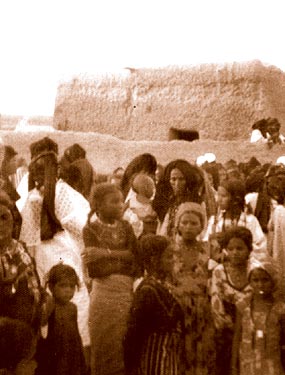 |
||
Ingal womenfolk |
||
 |
||
| holiday gathering |
||
 |
||
We also purchased two intricate brass Tuareg locks
to close our bags with and safeguard our possessions. For myself I bought
a beautiful knife, its hilt inlaid with patterns fashioned from different
metals and engraved with the smith's name and location in Tamashek on
the back, to wear under my skirts, on my leg right below the knee. Not
that I really deemed it necessary to wear a weapon; rather the dagger
had caught my fancy and it was a romantic idea to wear it in that way.
|
||
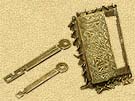  |
||
| Of far greater importance were 4 goatskins to carry our water provisions. Every single article we bought was genuine; tourists in this part of Niger were not numerous enough for it to be worth while to produce souvenir junk. | ||
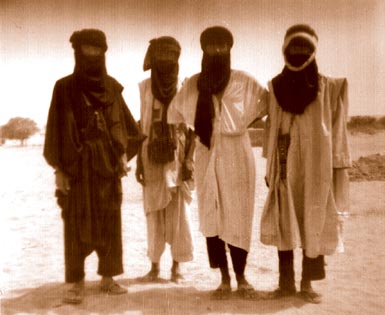 |
||
X with three Tuareg; spot the fake? (he's the
one on the left) |
||
| No question, we had to have such garments as well. To our dismay, the best indigo cloth, looking somewhat like carbon paper, was far too expensive for our budget. We had to settle for a lower quality, and after our clothes were sewn and we could wear them, our skin kept that blue tinge only for about a week or two. | ||
Furthermore, to look and feel genuine, X needed a
sword. It would have been futile to carry one without knowing how to
use it, so he arranged for a young Tuareg fellow to teach him. It was
fun watching the two men practicing their moves. |
||
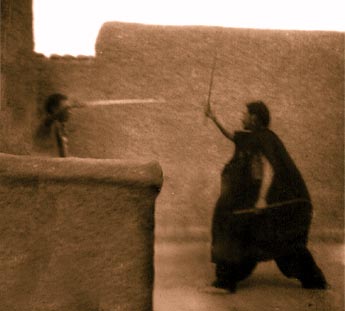 |
||
X (on the right) practicing his strokes |
||
| The cheeky young fellow had made some insulting remark to X, who, mean tempered as usual, replied with a slap in the face of the offender. The youth now pulled on the hilt of X's sword. X, trying to prevent the loss of his badge of manhood, held on to it and in a matter of a few seconds his antagonist had pulled the blade right through the flesh of X's fingers. The sword was freshly sharpened, and the tips of three fingers were cut halfway through, bleeding heavily unto the sand. | ||
| The youth fled, while we hurried to the village dispensary, a small shack at the outskirts of Ingal, as fast as we could; X gripping his injured and bloody hand with its partially severed finger tips. Luckily some nurse was in attendance and immediately started to apply stitches to close the gashes. Too many nerves were damaged though, and those three fingertips never got their full sensitivity back. | ||
| I was somewhat in shock as well, but in the back of my mind a pleasant glow of satisfaction was spreading, because for once my violent spouse had gotten his due. His injury didn't help to improve his temper over the next week or so. | ||
 |
||
| I became a frequent customer of a voluptuous, middle aged lady selling delicious chunks of yam root cooked in a yummy sauce. One day, on passing for another helping of her stew, I noticed a second person sitting on the ground under the awning with the vendor. Getting nearer, I made out an elderly fellow right behind the fat Mama who owned the stall. In front of the owner sat the customary bowl containing the yam, while at her side was a second bowl of about the same size. Squatting in the shade and starting on my portion of yam, I noticed the old man doing something to the woman's back. It took me a while to comprehend: While she was busily stirring her yams, the old man pressed a hollowed out cow's horn to her skin, then sucked forcefully on the other, small end of the horn, and quickly closed the opening with a piece of used chewing gum. After a few minutes, he removed the gum, took off the horn and emptied its content, consisting of lumps of clotted blood, into the second bowl filled with ashes. The procedure was repeated over and over on fresh parts of the skin of her back. With morbid fascination I watched the uncommon sight while eating my plate of yam. |
||
 |
||
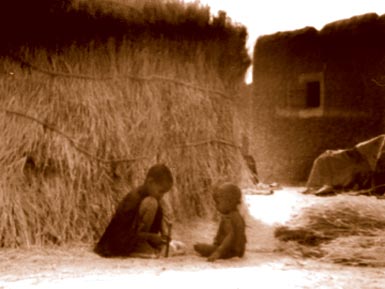 |
||
kids playing in back alley, Ingal |
||
| The Cure Salée is actually celebrated by both the Tuareg and Woodabe people as a sort of homecoming after their migrations far to the south during the dry season. They gather near Ingal because of the rich salt deposits there to rest, fatten their animals, give them the "salt cure," and enjoy each other's company through music, dancing, and frequently camel racing. The Woodabe manifestation of the Cure Salée is called the Gerewol and includes male "beauty pageants," where the young men adorn themselves with jewelry and makeup to accentuate the Woodabe ideals of beauty - long slender bodies, bright white teeth and eyes, and straight hair. Standing in a circle, singing a chant/song, and swaying to the music, the men seek to impress the onlooking young women and be chosen, sometimes for the night, sometimes for life. | ||
| Recently discovered dinosaur fossils also helped to make the region a popular destination. | ||
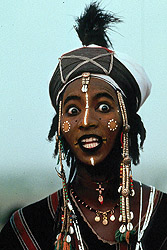 |
||
Peulh brave during beauty contest; photo:web |
||
| I'm glad I had the opportunity to visit the Ténéré region before big scale tourism set in. Surely today I wouldn't even recognize some of the places I've passed through in '74. | ||
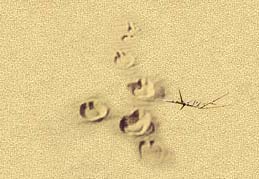 |
||
back to main index |
||